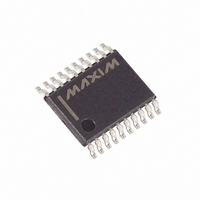DS1802E+ Maxim Integrated Products, DS1802E+ Datasheet - Page 8

DS1802E+
Manufacturer Part Number
DS1802E+
Description
IC POT DL AUDIO TAP W/PB 20TSSOP
Manufacturer
Maxim Integrated Products
Datasheet
1.DS1802.pdf
(17 pages)
Specifications of DS1802E+
Taps
64
Resistance (ohms)
45K
Number Of Circuits
2
Temperature Coefficient
750 ppm/°C Typical
Memory Type
Volatile
Interface
3-Wire Serial
Voltage - Supply
2.7 V ~ 5.5 V
Operating Temperature
-40°C ~ 85°C
Mounting Type
Surface Mount
Package / Case
20-TSSOP
Resistance In Ohms
45K
Lead Free Status / RoHS Status
Lead free / RoHS Compliant
DS1802
All contact closure control inputs, UC0, UC1, DC0, DC1, VU, VD, B0 and B1 are internally pulled up by
a 50 kO resistance. The UC0, UC1, DC0 DC1, VU, VD, B0, and B1 inputs are internally debounced and
require no external components for input signal conditioning.
3-WIRE SERIAL INTERFACE CONTROL
One method of communication and control of the DS1802 is accomplished through a 3-wire serial port
interface that drives an internal control logic unit. The 3-wire serial interface is designed for
microprocessor or microcontroller applications. The interface consists of three input signals which
include
, CLK and D.
RST
The
control signal is used to enable 3-wire serial port write operations. The CLK terminal is a clock
RST
signal input that provides synchronization for data I/O while the D signal input serves to transfer
potentiometer wiper position settings to the device.
As shown in Figure 5, a 3-wire serial port operation begins with a transition of the
signal input to a
RST
high state. Once the 3-wire port has been activated, data is clocked into the part on the low to high
transition of the CLK signal input. Data inp ut via the D line is transferred in order of the desired
potentiometer-0 value followed by the potentiometer-1 value.
The DS1802 contains two 65-position potentiometers whose wiper positions are set by an 8-bit value.
These two 8-bit values are written to the 16-bit I/O shift register which is used to store wiper position
during powered conditions. Because the potentiometer has 65-positions, only seven bits of data are
needed to set wiper position. A detailed diagram of the 16-bit I/O shift register is shown in Figure 5. Bits
0 through 7 are reserved for the potentiometer-0 control while bits 8 through 15 are reserved for control
of potentiometer-1.
Bits 0 through 5 are used for actual wiper positioning for potentiometer-0. Bit 6 is used to mute
potentiometer-0. If this bit has value 1, the potentiometer-0 wiper will be connected to the low end of the
resistive array. The mute feature of the DS1802 will be discussed in the section entitled “Mute Operation
of DS1802.” The value of bit 7 is a "don’t care" and will not affect operation of the DS1802 or
potentiometer-0.
Bits 8 through 13 are used for wiper positioning of potentiometer-1. Bit 14 is used for muting of the
potentiometer-1 wiper output. Bit 15, like bit 7, is a "don’t care" and will not affect operation of the
DS1802.
Data for the DS1802 is transmitted LSB first starting with bit 0. A complete transmission of 16 bits of
data is required to insure proper setting of each potentiometer’s wiper. An incomplete transmission may
result in undesired wiper settings.
Once the complete 16 bits of information has been transmitted and the
signal input transitions to a
RST
low state, the new wiper positions are loaded into the part.
8 of 17













